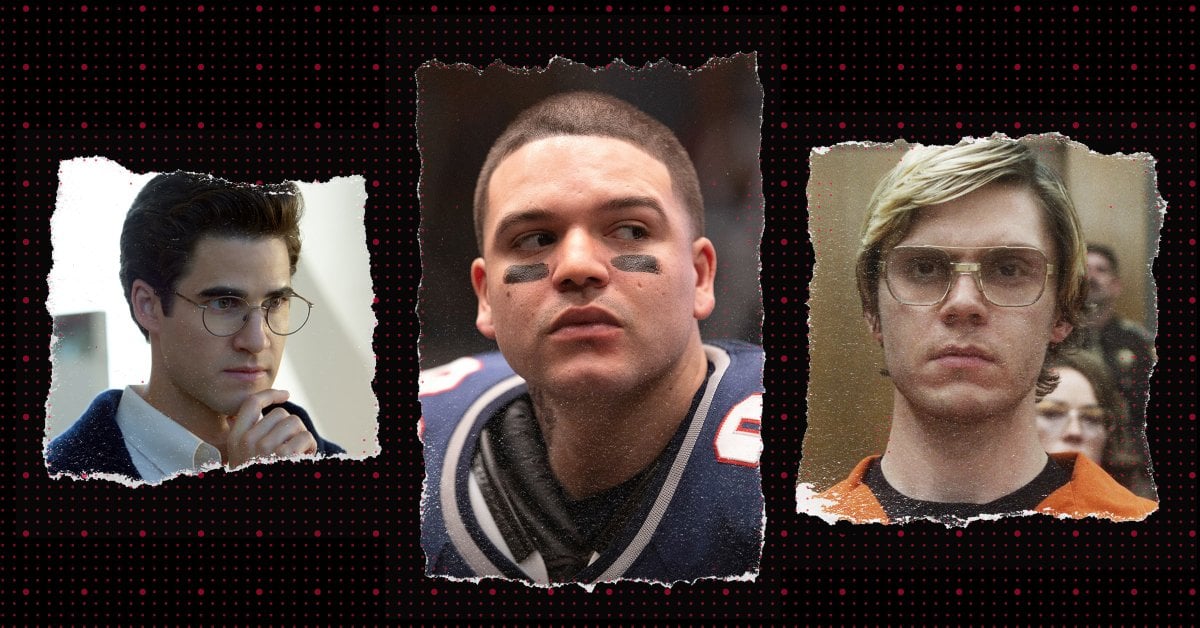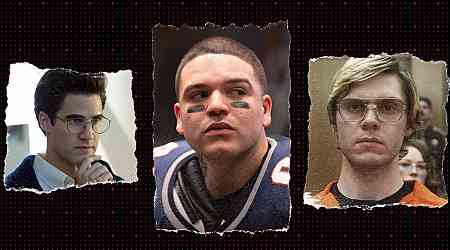
True crime. Horror. Celebrity. LGBTQ history. These are the genres and topics we tend to associate with Ryan Murphy, the megaproducer behind such TV hits as American Horror Story, American Crime Story, The Watcher, and his canonically “Obamacore” breakthrough, the high school musical dramedy Glee. Sports? Not so much. Which makes his latest foray into docudrama, American Sports Story, whose two-episode premiere airs Sept. 17 on FX, sound like a departure. It isn’t. The series’ debut season traces the rise and fall of NFL star turned convicted killer Aaron Hernandez—a saga that checks every one of Murphy’s familiar boxes.
[time-brightcove not-tgx=”true”]In fact, American Sports Story: Aaron Hernandez slots into one of his favorite niches: the queer murderer show. From The Assassination of Gianni Versace: American Crime Story to Monster: The Jeffrey Dahmer Story—whose platform, Netflix, drew criticism for labeling it “LGBTQ” content—Murphy is evidently fascinated by the true stories of men who have sex with men… and also kill. Hernandez isn’t even his only homoerotic true crime drama debuting this week. Due out Sept. 19 and devoted to Lyle and Erik Menendez, the second season of Monster is being promoted with a teaser that finds the parents-slaying brothers, whose sexuality came into question during their trial, locked in a bare-chested embrace. Unfortunately, the more Murphy investigates this very specific type of character, the muddier his message about the connection between queer men and murder becomes.
The shows are not carbon copies of one another. They diverge in tone, structure, and quality. Murphy’s roster of collaborators and level of involvement vary; so do the personalities of their predatory protagonists. Of the three series I’ve watched (Netflix has not provided critics with advance access to Menendez), the first to air, 2018’s Versace, is also by far the best. Written by Tom Rob Smith (Class of ‘09), the stylish period thriller, set largely in neon-lit ’90s Miami Beach, casts Glee’s Darren Criss as Andrew Cunanan, the status-obsessed spree killer who murdered five people, including the iconic fashion designer Gianni Versace (Édgar Ramírez). Both men were gay. Innovative in its reverse-chronological structure, Versace has shrewd satirical elements that recall American Psycho. And in contrasting Versace’s personal and professional success with Cunanan’s abjection and deceit, Smith captures a moment, concurrent with the second decade of the AIDS crisis, when the rapid mainstreaming of queer culture coexisted with virulent homophobia.

Murphy and his frequent collaborator Ian Brennan created and wrote the first four episodes of Dahmer, a slow, scuzzy season of TV that kicked off the Monster anthology in 2022. American Horror Story breakout Evan Peters plays an awkward, soft-spoken Jeffrey Dahmer, the notorious serial killer arrested in 1991 with an apartment full of stinking human remains. The first half of the excruciating 10-episode season luxuriates in Dahmer’s most revolting crimes; we watch him trap, drug, and tussle with his prey—mostly Black and brown gay men—and commit acts of cannibalism and necrophilia. Later episodes, some of which focus on innocent people, including a deaf victim (Rodney Burford) and a Good Samaritan neighbor (Niecy Nash-Betts), have a didactic bent. Characters painstakingly explain how racism, privilege, and—audaciously, for a show that spares no lurid detail in its dramatizations of real human beings’ suffering—a culture-wide curiosity about serial killers enabled Dahmer’s reign of terror. It’s a fictionalized snuff film followed by a lecture on why you shouldn’t watch snuff films.
Hernandez, created by Stu Zicherman (The Americans, The Shrink Next Door), is not an exercise in sadism like Dahmer. But it can be similarly frustrating in that both installments are needlessly, painfully long, and both mistake an overabundance of factual context for insight into their subjects. Hernandez, the 2010s New England Patriots tight end who was convicted of one murder, indicted for two more, and died by suicide in prison, has typically been discussed as a case in point for the dangers of football-induced traumatic brain injuries. Zicherman complicates that reading with scenes from Hernandez’s rough childhood, shallow but pervasive reminders of his drug abuse, depictions of his fraught relationship with sports stardom, and particularly a sustained exploration of the young father’s queer double life. Yet he never synthesizes those aspects of the story into a compelling read on Hernandez. Despite a movingly bewildered portrayal by Josh Rivera (The Hunger Games: The Ballad of Songbirds & Snakes), Aaron remains a collection of traits and circumstances in search of a character.
If there’s one thematic element that just about every Murphy production shares, it’s a fixation on the ways in which culture and environment shape individual identity and behavior. The maximalist, tell-don’t-show dialogue that is one of his stylistic signatures lends itself to exchanges that resemble newspaper op-eds more than spontaneous conversation. Murphy, who is gay, has often used these scripts to preach tolerance; I’d be hard pressed to name a TV creator who has managed to get more queer or trans characters on our screens. Several of them—from Glee’s bullied gay high schooler Kurt Hummel (Chris Colfer) to Blanca Rodriguez-Evangelista (Michaela Jaé Rodriguez), a trans woman who serves as a mother figure to a handful of queer youth of color in Murphy, Brad Falchuk, and Steven Canals’ ball-culture period drama Pose—come across as wonderful people. But as his career progresses, in series about dark, difficult gay geniuses like Truman Capote and Halston as well as in his ever-more-tawdry murder shows, Murphy seems to be growing increasingly interested in the way society’s stigmatization of an innocuous identity can transform queer men into monsters.

This devolution begins with the family. In Murphy’s world, you can be sure that behind every queer man who kills there is a cruel or absent father. Dennis Hernandez, who died suddenly when Aaron was 16, worked as a janitor after squandering his own potential as a local football star. The Dennis we meet in Hernandez, played by Vincent Laresca, can be tyrannical, abusive, and homophobic but also truly loves his son. (We know this because he mumbles as much when Aaron is out of earshot.) Cunanan was a few years older when his father, Modesto (Jon Jon Briones), fled to the Philippines to avoid arrest on embezzlement charges. The penultimate episode of Versace imagines the effect Modesto’s indulgence and eventual abandonment might have had on his boy. In Dahmer, the serial-killer protagonist’s dad, Lionel (Richard Jenkins), flees his eccentric wife, Joyce (Penelope Ann Miller), and troubled teenage son, only to learn that Joyce has left Jeffrey home alone for months, stewing in his own perversity. Years later, Lionel is haunted by guilt over his failure to intervene in Jeff’s antisocial behavior. (That the Menendez brothers had deep-seated daddy issues probably goes without saying.)
Then comes the wider culture, where supporting characters often serve as case studies in systemic oppression or resistance more than as multifaceted people. The cops in Dahmer are nasty, corrupt white guys who might be more repulsed by Jeff’s sexuality than they are by his crimes. Because they don’t care about the poor, Black residents of his building, they ignore repeated requests from Nash-Betts’ Glenda Cleveland to investigate his reeking apartment and alarming behavior. A gay, half-Filipino outsider whose whole life is a quest to attain money, power, and fame, Versace’s Andrew is constantly underestimated and othered; no wonder he takes out his rage on the rich white men, like Gianni and real-estate mogul Lee Miglin, whose elite world he can never penetrate. Hernandez scrutinizes the racism, classism, and homophobia endemic to pro sports, where an overwhelmingly white hierarchy of coaches and owners exploit the bodies of Black and brown men—and openly queer athletes are rare.
At times, these shows, particularly Hernandez, come perilously close to painting their queer murderers as victims. Sure, they make the obligatory effort to humanize the actual victims—Versace more convincingly than Hernandez and Dahmer, perhaps because its namesake is still more famous than the man who shot him. (Dahmer faced backlash from some families of those slain, who called the show “retraumatizing” and said they weren’t so much as contacted about it. Murphy has said that his research team did reach out to the families.) A more insightful, if by now repetitive, theme of Murphy’s queer-murderer shows is the reminder that these predators often prey on other queer people as well as members of racially or economically marginalized communities. Viewers observe how the devaluation of these lives by mainstream society, as represented by institutions like the police, the media, and the legal system, can make all of us accomplices to a Jeffrey Dahmer or an Aaron Hernandez.

But no amount of socially conscious window dressing can conceal that the real draw is always the killers, who so bankably appeal to our true-crime-addicted lizard brains. That’s not a problem unique to Murphy; it’s endemic to a genre fascinated by psychopathology and fueled by real people’s pain. What’s singularly disturbing about the queer-murderer shows is how closely the portraits they paint of their subjects have come to resemble one another, on a thematic level. The more of them we get, the stronger the message becomes that the formula for homicidal derangement is same-sex attraction + bad dad + broken society, with a side of substance-abuse issues and sometimes a history of sexual abuse. And the easier it gets to internalize the misapprehension that the most salient thing these characters have in common is that they sleep with men, not that they’re cold-blooded killers. Taken together with the Halston and Capote shows (along with no small number of characters in Murphy’s fictional series), the implication is that this specific form of difference predestines a person to loneliness and anger and misery, to killing or being killed, regardless of anything else that might be happening in their lives.
In an interview that addressed the mixed reactions to Dahmer, which was a huge hit for Netflix, Murphy expressed exasperation with his critics. “I… don’t think that all gay stories have to be happy stories,” he said. Later in the same conversation, he wondered aloud: “What are the rules now? Should we never do a movie about a tyrant?” The answer, for anyone who cares about art more than the appearance of propriety, is of course you should. One-dimensional representation, positive or negative, is just propaganda; Pose remains one of Murphy’s greatest achievements, in part, because it showcases a broad range of LGBTQ characters, from saintly heroes to pithy villains to teens making the same mistakes everyone makes at their age. The trouble comes once you make three or four or a dozen different TV shows about the same kind of bad guy, and suddenly your nuanced representation starts to look monolithic in a way you may have never intended.




























